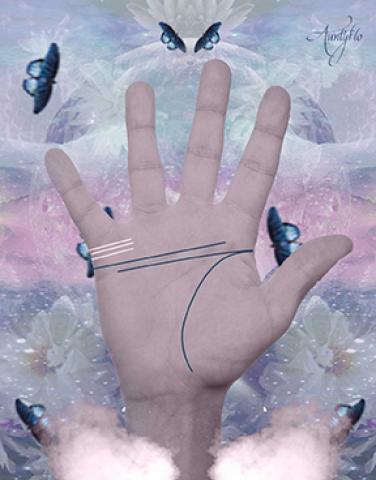Palmistry Minor Lines

Palmistry is the study of the palm of the hand and is an ancient art practised across many cultures and many areas of the world. It's believed to have begun in India and China, by Hindu Brahmaists and Chinese holy men in the Zhou Dynasty around 3,000 years ago. The aim of palmistry is to learn more about oneself and discover the path one's life might take. By using the major lines, the Heart Line, Life Line, Wisdom Line and Fate Line, the general character of a person can be discovered and the broad details of their life determined. However, skilled palmistry practitioners look beyond the major lines to the minor lines - here lies the details that make up a person's innermost desires, beliefs and dreams. These minor lines, also known as secondary lines, differ from individual to individual and so provide a deeper look into a person's character and life.
These minor lines can reveal an individual's talents, strengths and weaknesses, and interests. Some lines are very faint or don't appear on the palm - whether they do or not gives the palm reader more insight into their subject, the individual whose palm is being read. Remember that in palmistry, the right hand is always the hand that is read: the left palm gives congenital information, related to a person's inherited genetics and family history, whilst the right hand gives postnatal information - information after birth. The left hand can be used to gain information or insight about what the right-hand says by providing a genetic history.
Here we'll discuss the most commonly visible minor lines, and avoid the lines that are not present on the majority of the population. This article will explore the Marriage Lines, Sun Line, Children Line, Health Line, Bracelet Lines and Intuition Line.

Bracelet Lines In Palmistry
If you see above you will see the bracelets. I'm going to start with this meaning before moving onto the minor lines. Bracelet Lines, also known as Rascette Lines, are located on the wrist where you would wear bracelets, at the base of the palm. Most people have three bracelet lines, but some have four - this suggests the person will live to up to 100 years old! These lines give us clues about a person's health, prosperity and longevity. The more solid and unbroken the lines, the better the chances are of living a good healthy life.
The bracelet line closest to the palm is for our youth, the middle for adult life, and the last for old age. Thick, long and straight lines mean good health in whatever age the line represents. A curved, thin or broken line usually means poor health and a weak body - this is most commonly found in the last line for old age. Islands usually mean kidney, heart or lung issues and crosses means that individuals are not taking care of themselves and suffer from avoidable conditions - perhaps due to substance abuse, smoking and poor diet.
The Rings In Palmistry
Each finger can have a ring, and each one means something different. A ring around the index finger is called the Ring of Solomon or the Ring of Jupiter. The ring can appear in a straight line or semi-circle variation. Traditionally, this ring represents King Soloman from the Bible and Jupiter, the king of the Roman gods. For this reason, those who have this ring are usually leaders and found in positions of authority. They will be well respected, intelligent and well suited to these roles.
A ring on the middle finger is called the Ring of Saturn and is quite rare. It tends to mean an individual will lead a reclusive and unhappy life due to their serious nature. They may be a very pessimistic person by nature, or constantly unhappy.
Meanwhile, a ring on the ring finger is called the Ring of Apollo and indicates a blockage of creativity at some point in the individual's life. It means individuals are creative but have to try harder to overcome the creative blocks they meet in their life - palmists believe this line is not in itself bad but leads to greater growth in overcoming its effects.
Palmistry is a complex and fascinating subject, and these minor lines and their meaning just scratch the surface of what can be discovered about an individual from their palms. By studying the Major and Minor Lines, much can be learned about a person's innate character traits and what course their life may follow!
By Florance Saul
Jun 30, 2020












